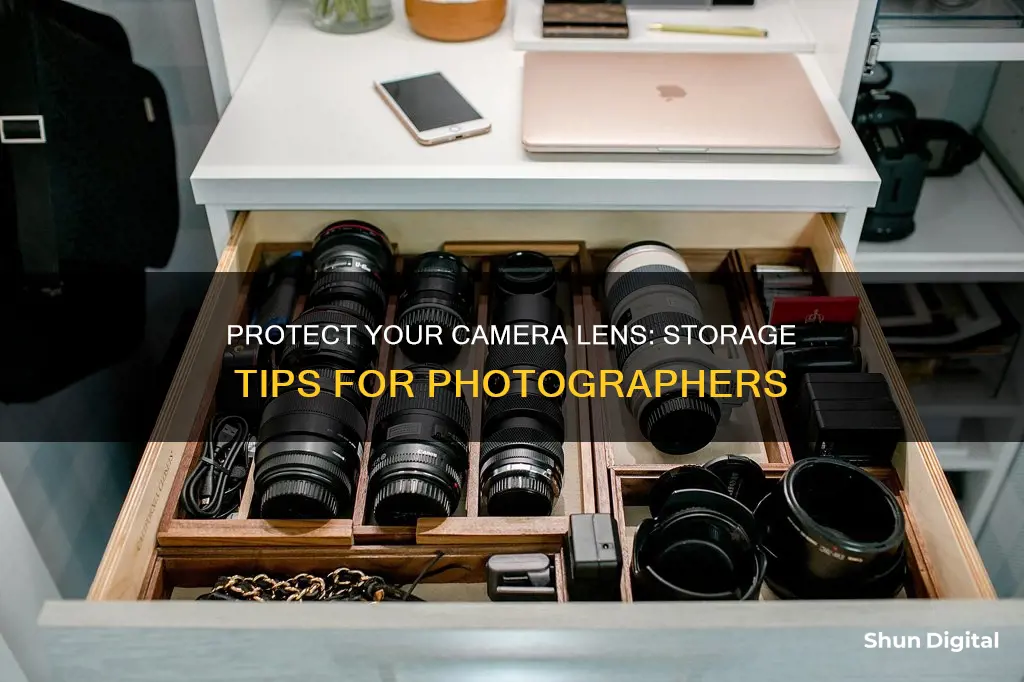
Camera lenses are valuable and require proper care and storage to maintain their optical quality and longevity. Lenses are fragile and can easily be damaged by dust, dirt, oils, and changing weather conditions. Therefore, it is important to know how to store them properly to protect them from these elements and accidental mishaps.
There are several storage solutions available for lenses, including camera bags, lens pouches, dry cabinets, and custom-built storage solutions. When storing lenses, it is recommended to keep them in a cool, dry place, away from direct sunlight, and to use lens caps and lens hoods for protection. Regular cleaning and maintenance are also important to ensure the lenses remain in good condition.
| Characteristics | Values |
|---|---|
| Store them | Front-element-side-down |
| Aperture rings | Closed to the smallest f-stop |
| Storage space | Air-tight and dry |
| Store with | Caps on |
| Avoid | Direct sunlight and heat sources |
| Use | Silica gel packets or other desiccants |
| Use | Shelves or drawers |
| Store | Vertically with the front-facing upward |
| Maintain | Constant temperature and humidity |
| Clean | With a soft, lint-free microfiber cloth |
| Use | Lens pouches or cases |
| Use | Lens hoods |
| Store | In padded camera bags with designated compartments |
What You'll Learn

Use silica gel to prevent fungus
To prevent fungus, it is important to keep your camera lenses dry. Fungi thrive in humid, dark, and moist environments, so it is crucial to store your lenses in a dry, well-ventilated space. This is where silica gel comes in.
Silica gel is a desiccant, meaning it absorbs and retains moisture, helping to keep your lenses dry. You may be familiar with those little paper bags filled with silica gel packets that come with new shoes or other consumer goods. These are included to absorb any humidity and keep the product dry during shipping and storage.
For camera lenses, you can use silica gel in a similar way. Place a cup of silica gel in an old sock with a knot tied at the top and place it in your lens storage box. This will help keep your lenses dry and free from fungal growth. You can also purchase silica gel packets or reusable silica gel containers designed specifically for this purpose. Reusable containers are particularly useful because they often have an indicator that tells you when they are no longer effective, and you can easily reactivate them by applying heat.
When using silica gel, it is important to remember that it needs to be replaced or reactivated once it has absorbed moisture. Additionally, silica gel should be used in conjunction with other good storage practices, such as keeping your lenses in a dry, airtight box or cabinet, and ensuring your lenses are thoroughly cleaned and dried before storage.
By using silica gel and following proper storage techniques, you can effectively prevent fungal growth on your camera lenses, protecting your equipment and maintaining their performance and resale value.
The High Cost of Camera Lenses: Why So Expensive?
You may want to see also

Store in a dry, well-ventilated area
When storing camera lenses, it is important to keep them in a dry, well-ventilated area to protect them from damage. Humidity, water, dust, and extreme weather conditions can all cause harm to lenses, so it is crucial to take the necessary steps to prevent this.
One way to ensure your lenses stay dry is to store them in a dry cabinet or dry box. These storage units regulate humidity levels to prevent mildew, mould, and rust from forming on your lenses. They are ideal for long-term storage and come in various sizes to accommodate different lens collections. Some dry cabinets have additional features such as LED lights, adjustable shelves, and locking systems.
If you live in an area with high humidity, consider investing in a dehumidifier to maintain optimal humidity levels between 35% and 50%. This will create a suitable environment for your lenses and prevent moisture-related issues.
In addition to using dry storage solutions, there are other measures you can take to protect your lenses. For example, you can use lens caps to prevent scratches when lenses are not in use. However, some people choose to store their lenses without caps to allow ambient light to penetrate and inhibit the growth of fungi. Regularly cleaning your lenses with a soft, dry cloth or specialised cleaning accessories will also help to remove dust, fingerprints, and oil that can accumulate over time.
By storing your camera lenses in a dry, well-ventilated area and taking preventative measures, you can effectively protect your equipment and maintain its optical integrity and image resolution.

Avoid extreme temperatures
Extreme temperatures can damage the lens coatings and internal mechanics of your camera. Intense heat or cold can cause your camera to temporarily malfunction or suffer permanent damage. Most cameras are rated to work between 14-104 degrees Fahrenheit (-10 and +40 degrees Celsius). This is generally not because of the camera itself, but because of the batteries – the chemicals inside them cease to work properly when they get too cold or too hot.
To avoid this problem, keep an extra battery in a temperature-controlled place. If you’re shooting in the cold, keep one in your pocket to be warmed by your body heat. In the heat, your camera bag should provide adequate shade to keep a battery cool enough to function.
Never place your camera face up in direct sunlight. The lens works both ways and can act like a magnifying glass to focus the rays into your camera and burn a hole in your shutter and eventually your image sensor. Remember that even magnesium-alloy cameras contain plastic components, so if you shoot in really extreme places, such as near volcanoes or among raging fires, use common sense and keep your camera well clear of the flames.
If you're heading to a cold destination, condensation can also be an issue. If you venture out in negative temperatures, you’ll find frost develops on your camera quite quickly. If your camera has frozen or developed frost all around it, put it straight in your camera bag and don’t open it again until the morning. Give it a good long rest in the bag to slowly adjust to a warmer temperature.
If you’re out and about and it’s reaching negative or very close to freezing temperatures, you will notice your camera battery depletes very rapidly. The colder it is, the faster your battery will run out so always be sure to have a spare, or three if you plan on being outdoors all day.
The best way to ensure you don’t run out of battery power is to always keep a spare in a pocket close to your body, so it stays warm and fully charged.

Use lens caps to prevent dust
Lens caps are an essential accessory for any photographer wanting to protect their camera lenses from dust and other debris. Dust can be extremely harmful to camera lenses, causing scratches on the surface and aberrations or soft edges in photographs. In addition, dust particles can absorb light and cause issues with the aperture blades, making it difficult for the lens to focus properly. Therefore, it is crucial to take steps to prevent dust from accumulating on your lenses, and one of the simplest and most effective ways to do this is by using lens caps.
Lens caps are designed to shield the front and rear elements of your lenses from dust and other contaminants. They are typically made of plastic or metal and can be easily attached to the lens, providing a physical barrier that keeps dust at bay. It is recommended to always use both front and rear lens caps when your camera is not in use. This simple practice can go a long way in ensuring your lenses remain clean and dust-free.
However, it is important to note that lens caps themselves can also attract dust. When handling lens caps, be mindful of where you place them to avoid picking up dust and debris. It is a good idea to clean your lens caps regularly and keep them in a safe place when not in use. Additionally, consider investing in multiple lens caps so that you always have a clean one ready to use.
Another benefit of using lens caps is that they can help protect your lenses from accidental damage. For example, if you accidentally drop your lens, the lens cap can act as a buffer and reduce the impact, potentially saving your lens from cracks or other damage.
In conclusion, lens caps are a vital tool in the photographer's arsenal for preventing dust and keeping camera lenses in optimal condition. By consistently using lens caps and adopting good lens handling practices, you can significantly reduce the amount of dust that accumulates on your lenses and maintain the optical integrity and image resolution of your equipment.

Store vertically, front-facing upward
Storing your camera lenses vertically and front-facing upward is a safe option. The front element of the lens is less likely to get damaged if it's facing upward. This is because, if the lens is stored facing downward, the weight of the camera will be on the lens, which can be harmful to the lens in the long run.
However, it is important to note that the orientation of the lens is not a risk factor. The things that can hurt lenses in storage are extreme heat, humidity, and the presence of fungus. Therefore, it is important to store your lenses in a place that is air-tight and dry.
Frequently asked questions
Camera lenses are delicate and can easily be damaged by dust, dirt, water, extreme weather, and blunt force. To protect your lenses, you should store them in a safe place, such as a cabinet or drawer, and use lens caps and lens pouches or cases to shield them from potential hazards.
High humidity can cause fungus to grow on your camera lenses, so it's important to store them in a dry place. You can use silica gel packets or desiccants to control moisture levels and prevent fungus.
If you have multiple lenses, it's a good idea to use shelves or drawers specifically designed for camera equipment to keep them organised and accessible. You can also invest in a dry cabinet to protect your lenses from humidity.
Yes, cleaning your camera lenses before storing them is important to remove dust, fingerprints, and moisture that could affect their performance over time. Use a soft, lint-free microfiber cloth to gently wipe away any debris, and a lens-cleaning solution for stubborn smudges.
When travelling, use a padded camera bag with designated compartments for lenses to protect them from damage. Keep the bag in the passenger area of your vehicle, as temperature fluctuations can be more extreme in the trunk.







